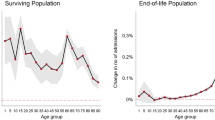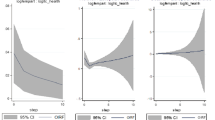Abstract
Recent evidence indicates that the relationship between age and health care expenditure is not as straightforward as it appears. In fact, micro-level studies find that time to death, rather than ageing, is possibly the main driver of the escalating health care costs in developed countries. Unfortunately, the evidence at the macro level is less clear and often depends on the specification of the empirical model used. We use an aggregate demand framework to assess whether health expenditure is more likely to be driven by ageing per se or proximity to death. Using panel data from 22 OECD countries from the first half of the 1990s, we find population ageing to be negatively correlated with health expenditure once proximity to death is accounted for. This suggests that the effects of ageing on health expenditure growth might be overstated while the effects of the high costs of medical care at the end of life are potentially underestimated. With respect to the latter, our finding highlights the importance of long-term and hospice care management. An expanded long-term care program may not only improve patient welfare, but also reduce costs of care by reducing the duration of hospital care for terminally ill patients. If expensive medical treatment for patients near the end of life can be controlled for, health expenditure growth resulting from population ageing is unlikely to present a most serious problem.
Similar content being viewed by others
References
Australian Institute of Health and Welfare. (2002). Australia’s Health 2002. Canberra: AIHW.
Baker C., Beebe J., Lubitz J. (1995) Longevity and medicare expenditure. The New England Journal of Medicine 332(15): 999–1003. doi:10.1056/NEJM199504133321506
Barros P.P. (1998) The black box of health care expenditure growth determinants. Health Economics 7: 533–544. doi:10.1002/(SICI)1099-1050(199809)7:6<533::AID-HEC374>3.0.CO;2-B
Carey, D. (1999). Coping with population ageing in Australia. OECD Economics Department Working Papers, #217. Paris: OECD.
Chernichovsky, D., & Markowitz, S. (2001). Toward a framework for improving health care financing for an ageing population: The case of Israel. NBER Working Paper, #8415.
Felder S., Meier M., Schmitt H. (2000) Health care expenditure in the last months of life. Journal of Health Economics 19: 679–695. doi:10.1016/S0167-6296(00)00039-4
Fuchs, V. R. (1998). Health care for the elderly: How much? Who will pay for it? NBER Working Paper, # 6755.
Fuchs, V. R. (2001). The financial problems of the elderly: A holistic approach. NBER Working Paper, # 8236.
Garber, A. M., MaCurdy, T. E., & McClellan, M. L. (1998). Medical care at the end of life: Diseases, treatment patterns, and costs. NBER Working Paper, # 6748.
Gerdtham U.-G., Sogaard J., Anderson F., Jonsson B. (1992) An econometric analysis of health care expenditure: A cross-section study of the OECD countries. Journal of Health Economics 11: 63–84. doi:10.1016/0167-6296(92)90025-V
Getzen T.E. (1992) Population ageing and the growth of health expenditures. Journal of Gerontology: Social Sciences 47: S98–S104
Hogan C., Lunney J., Gabel J., Lynn J. (2001) Medicare beneficiaries’ costs of care in the last year of life. Health Affairs 20(4): 188–195. doi:10.1377/hlthaff.20.4.188
Jorgenson, D. W., Slesnick, D. T., & Stoker, T. M. (1987). Two-stage budgeting and the consumer demand for energy. In J. R. Moroney (Ed.), Advances in the economics of energy and resources (Vol. 6, pp. 125–162). Greenwich, CT: JAI Press.
Jorgenson, D. W., & Stoker, T. M. (1984). Aggregate consumer expenditure on energy. In J. R. Moroney (Ed.), Advances in the economics of energy and resources (Vol. 5, pp. 1–84). Greenwich, CT: JAI Press.
Lamers L.M., van Vliet R.C.J.A. (1998) The high cost of death: Should plans get higher payments when members die? Medical Care 36: 1451–1460. doi:10.1097/00005650-199810000-00003
Lubitz J.B., Riley G.F. (1993) Trends in medicare payments in the last year of life. The New England Journal of Medicine 328(15): 1092–1096. doi:10.1056/NEJM199304153281506
Meerdin W.J., Bonneux L., Polder J.J., Koopmanschap M.A., van der Maas P.J. (1998) Demographic and epidemiological determinants of healthcare costs in Netherlands: Cost of illness study. British Medical Journal 317: 111–115
Newhouse J.P. (1992) Medical care costs: How much welfare loss?. The Journal of Economic Perspectives 6(3): 3–21
O’Connell J. (1996) The relationship between health expenditures and the age structure of the population in OECD countries. Health Economics 5: 573–578. doi:10.1002/(SICI)1099-1050(199611)5:6<573::AID-HEC231>3.0.CO;2-L
OECD. (2002). OECD health data (4th ed.). Paris: OECD.
O’Neill C., Groom L., Avery A.J., Boot D., Thornhill K. (2000) Age and proximity to deaths as predictors of GP care costs: Results from a study of nursing home patients. Health economics 9: 733–738. doi:10.1002/1099-1050(200012)9:8<733::AID-HEC564>3.0.CO;2-U
Richardson, J., & Robertson, I. (1999). Ageing and the cost of health services. In Policy implications of the ageing of Australia’s population, conference proceedings. Melbourne: Productivity Commission and Melbourne Insititute of Applied Economic and Social Research.
Schellhorn M., Stuck A.E., Minder C.E., Beck J.C. (2000) Health services utilization of elderly Swiss: Evidence from panel data. Health Economics 9: 533–545. doi:10.1002/1099-1050(200009)9:6<533::AID-HEC532>3.0.CO;2-V
Skinner, J., & Wennberg, J. E. (1998). How much is enough? Efficiency and medicare spending in the last six months of life. NBER Working Paper, # 6513.
Spillman B.C., Lubitz J. (2000) The effect of longevity on spending for acute and long-term care. The New England Journal of Medicine 342(19): 1409–1415. doi:10.1056/NEJM200005113421906
Stearns, S. C., & Norton, E. C. (2002). Time to include time to death? The future of health care expenditure predictions. Trangle Health Economics Working Paper Series, # 4, University of North Carolina at Chapel Hill.
van Weel C., Michels J. (1997) Dying, not old age, to blame for costs of health care. Lancet 350: 1159–1160. doi:10.1016/S0140-6736(97)08312-8
Waldo D.R., Sonnefeld S.T., McKusick D.R., Arnett R.H., (1989) Health expenditures by age group, 1977 and 1987. Health Care Financing Review 10(4): 116–120
Zweifel P., Felder S., Meiers M. (1999) Ageing of population and health care expenditure: A red herring?. Health Economics, 8: 485–496. doi:10.1002/(SICI)1099-1050(199909)8:6<485::AID-HEC461>3.0.CO;2-4
Zweifel, P., & Ferrari, M. (1992). Is there a Sisyphys syndrome in healht care? In P. Zweifel & H. E. Frech, III. (Eds.), Health economics worldwide. Developments in health economics and public policy series (Vol. 1, pp. 311–330). Boston and Dordrecht: Kluwer Academic, Norwell, Mass.
Zweifel P., Steinmann L., Eugster P. (2005) The Sisyphus syndrome in health revisited. International Journal of Health Care Finance and Economics 5: 127–145. doi:10.1007/s10754-005-1864-6
Author information
Authors and Affiliations
Corresponding author
Rights and permissions
About this article
Cite this article
Palangkaraya, A., Yong, J. Population ageing and its implications on aggregate health care demand: empirical evidence from 22 OECD countries. Int J Health Care Finance Econ 9, 391–402 (2009). https://doi.org/10.1007/s10754-009-9057-3
Received:
Accepted:
Published:
Issue Date:
DOI: https://doi.org/10.1007/s10754-009-9057-3




